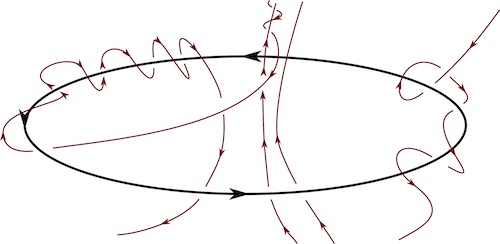School
centre Paul Langevin
https://sites.google.com/view/adrienboulangermaths/home/aussois-2022
Date(s) : 12/12/2022 - 16/12/2022 iCal
0 h 00 min
L’édition 2022 de l’école d’hiver d’Aussois se tiendra du 12 au 16 décembre 2022, au centre Paul Langevin comme à son habitude.
Le programme.
Le menu est le même que pour les 3 éditions précédentes : quatre mini-cours de trois heures et quelques exposés donnés par les participants. Pour ce qui est des les mini-cours, le quatuor de cette année sera joué par
Spectre du laplacien sur le groupe de Grigorchuk et iteration d’application rationnelle.
Dans ce mini-cours, on va étudier le groupe de Grigorchuk et on va définir ce que l’on entend par spectre du laplacien sur un groupe. Enfin dans ce cas particulier, je montrerai comment ce spectre est relié à l’itération d’un système dynamique holomorphe à deux variables. En particulier on étudiera un courant canonique associé à notre système dynamique en question et on montrera comment couper ce courant pour retrouver le spectre recherché.
Scindements de Heegaard, trisections, et plus si affinités.
Un scindement de Heegaard est une décomposition d’une variété de dimension trois en deux corps-en-anses collés le long de leurs bords. Un tel scindement peut être représenté par un diagramme donné par deux familles de courbes sur une surface fermée. On verra les résultats d’existence et d’unicité de ces décompositions et on décrira des exemples. La notion analogue en dimension 4, récemment introduite par Gay et Kirby, est la notion de trisection : les variétés lisses de dimension 4 peuvent être découpées en trois corps à 1-anses, qui s’intersectent deux-à-deux le long de corps-en-anses de dimension 3 et globalement le long d’une surface fermée. On verra à nouveau des résultats d’existence et d’unicité, analogues à la dimension 3. Pour finir, on discutera les adaptations possibles en dimension supérieure.
Length orthospectrum of convex bodies and zeta functions.
I will start by recalling the definition of the classical Epstein zeta function which can be viewed as an « higher-dimensional » generalization of the Riemann zeta function. I will explain how this function can be interpreted in terms of convex geometry, and more specifically in terms of the length orthospectrum of two convex bodies. The Epstein zeta function corresponds to the case where the convex bodies are reduced to points. I will show that such functions can be defined for more general strictly convex bodies and what type of geometric quantities it encodes (e.g. mixed volumes). These questions are in fact naturally related to the dynamical properties of the geodesic flow on the torus. Using tools from harmonic analysis and from the theory of currents, I will give a sharp analytical description of these flows and I will connect this with the basic properties of these functions. Finally, if time permits, I will explain how these methods extend in the negatively curved setting to deal with the analytical properties of the so-called Poincaré series.
Introduction to mathematical relativity
The goal of this mini-course is to see how the postulates of special and general relativity translate into mathematical models and equations. A part of the course will cover the prerequisite notions of Lorentzian geometry (metrics, the Levi-Civita connection, curvature, parallel transport, geodesics etc). We look at the role of the Minkowkski metric in special relativity and we deduce the Einstein Equations of general relativity. Time permitting, we discuss the constraint equations of general relativity, which allow us to describe space-times as solutions of an initial value problem.
Si vous êtes intéressés par la conférence, vous pouvez écrire à l’un des organisateurs pour vous inscrire ;
-
Adrien Boulanger (prenom.nom@univ-amu.fr), I2M, Marseille
-
Pierre Dehornoy (prenom.nom@univ-grenoble-alpes.fr)
-
Hélène Eynard-Bontemps (prenom.nom@univ-grenoble-alpes.fr)
-
Charles Fougeron (nom@math.univ-paris13.fr)
-
Selim Ghazouani (s.nom@ic.ac.uk)
Participants
-
Cipriana Anghel
-
Adrien Boulanger
-
Yann Chaubet
-
Joachim Brum
-
Yenni Cherik
-
Thierry Coulbois
-
Nguyen-Bac Dang
-
Pierre Dehornoy
-
Farid Diaf
-
Hélène Eynard-Bontemps
-
Charles Fougeron
-
Frédéric Faure
-
Selim Ghazouani
-
Magali Jay
-
Hodayfa Labbi
-
Pierre Lazag
-
Felix Lequen
-
Florestan Martin-Baillon
-
Théo Marty
-
Martin Mion-Mouton
-
Delphine Moussard
-
Alan Pinoy
-
Anne Pichon
-
Ulysse Remfort
-
Gabriel Rivière
-
Rares Stan
-
Florent Talleri
-
Sarah Timhadjelt
-
Michele Triestino
-
Caterina Vâlcu
-
Ioannis Yakovoglou
Emplacement
IHP - Institut Henri Poincaré
Catégories

